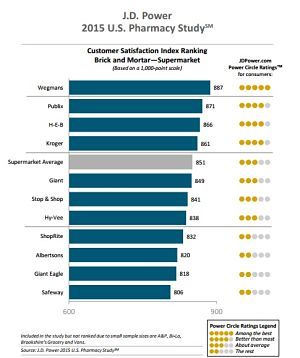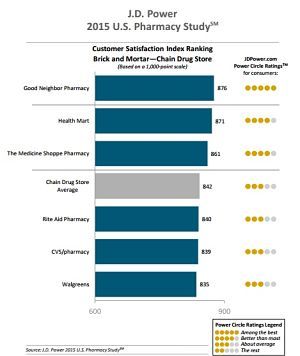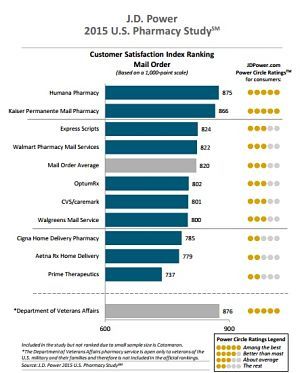Article
Drugstore Chains, Supermarkets See Boost in Customer Satisfaction
Author(s):
Customer satisfaction with supermarket and drugstore chain pharmacies has improved in the last year, while ratings for mail-order and mass-merchandiser pharmacies have dropped, according to the J.D. Power 2015 US Pharmacy Study.
Customer satisfaction with supermarket and drugstore chain pharmacies has improved in the last year, while ratings for mail-order and mass-merchandiser pharmacies have dropped, according to the J.D. Power 2015 US Pharmacy Study.
Supermarkets’ overall customer satisfaction scores improved from 843 in 2014 to 851 this year, while chain drug stores’ ratings improved by 2 points.
Wegmans, with 887 points out of a possible 1000, earned the highest honors overall and among supermarket pharmacies, followed by Publix and H-E-B.

Wegmans circulated a press release celebrating its pharmacy satisfaction score.
“Our pharmacy employees have built relationships with our customers that start with caring,” stated CEO Danny Wegman. “The results of this study are important because they show the extent to which our customers value those relationships and trust our people.”
Good Neighbor Pharmacy, with 876 points, ranked highest in the brick-and-mortar drugstore chain segment, followed by Health Mart and The Medicine Shoppe.
In a press release, Good Neighbor Pharmacy noted that this was the third year it had taken the top honor in this category and the fifth recognition in 6 years.
"The recognition by J.D. Power is a tremendous honor and indicative of the efforts and achievements of the thousands of independent pharmacists who make up Good Neighbor Pharmacy," Dave Neu, president of Good Neighbor Pharmacy at AmerisourceBergen, said in the release.

National Community Pharmacists Association CEO B. Douglas Hoey congratulated independent community pharmacists at these 3 top pharmacies for their high scores.
“Locally owned and operated pharmacies Good Neighbor Pharmacy, Health Mart, and The Medicine Shoppe Pharmacy bested the competition in their market segment of the survey,” Hoey said in a statement. “The patient-first approach of these and all independent community pharmacies to customer service resonates with consumers and this study reaffirms that fact.”
On the other hand, mail-order pharmacies’ customer satisfaction ratings dropped from 822 in 2014 to 820 in 2015, and mass-merchandiser pharmacies’ ratings declined from 830 in 2014 to 822 in 2015.
Target, with 858 points, nabbed the top spot among mass-merchandiser pharmacies, with Sam’s Club and Meijer following.

Among the mail-order pharmacies, Humana Pharmacy (875 points), Kaiser Permanente Mail Pharmacy, and Express Scripts ranked in the top 3, respectively.

Lower-scoring pharmacies may want their employees to start asking patients if they would like to speak with a pharmacist when dispensing medications, because this led to a 54-point bump in customer satisfaction. Speaking with a pharmacist also increased the likelihood that a patient would buy other products in the store and be more loyal to the pharmacy.
Other offerings, such as a private space to consult with a pharmacist, also improved customer satisfaction scores.
“While 44% of customers who speak with a pharmacist ‘strongly agree they feel loyal to their pharmacy,’ only 35% of those who do not speak with a pharmacist say the same,” the report stated.
Customers who used health testing and wellness services were also more likely to recommend a pharmacy and feel loyal to their store. These services also upped the odds of customers purchasing non-prescription products.
Being able to obtain the next refill before running out of medication was a big factor for customer satisfaction for both brick-and-mortar and mail-order pharmacies. The study reported that 91% of customers who frequent brick-and-mortar pharmacies get their prescription when or before promised.
The average amount that customers at brick-and-mortar pharmacies pay out-of-pocket for prescriptions increased by a dollar to $23 this year, while the average price customers paid out-of-pocket at mail-order pharmacies decreased from $35 to $32 this year.
“The health care industry has undergone tremendous changes in recent years, and more changes are coming, so stable customer satisfaction with pharmacies is very positive,” said Rick Johnson, director of the health care practice at JD Power, in the report. “Pharmacies serve as a benchmark for other entities in the health care ecosystem, as they continue to have the highest levels of customer satisfaction in the health care industry, demonstrating that focusing on customer satisfaction is good for both patients and businesses.”
The survey involved 14,914 customers who had filled or refilled a prescription during the 3 months prior to the survey period, which was between May and June 2015.
Customer satisfaction ratings for brick-and-mortar pharmacies were based on prescription ordering, store, cost competitiveness, non-pharmacist staff, and pharmacists. For mail-order pharmacies, the ratings measured happiness with cost competitiveness, prescription delivery, prescription ordering process, and customer service experience.





